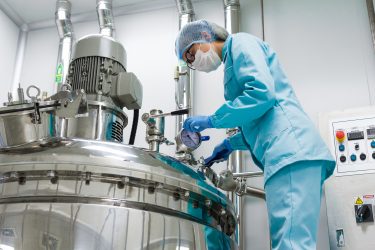Sustainable energy strategies for pharmaceutical manufacturers
Posted: 15 July 2022 | Andrew Toher (Enel X) | 1 comment
In this article, Andrew Toher, Head of Customer Insights Europe at Enel X, delves into the potential benefits and key considerations of a sustainable energy strategy.


The pharmaceutical sector is not typically seen as a highly polluting, ‘heavy industry’ but it is far from green. In its 2021 report Delivering a ‘Net Zero’ National Health Service, the UK’s NHS attributes as much as a quarter of its carbon footprint to medicines. A deep carbon footprint is a common hallmark of energy intensive manufacturing processes – and the manufacture of pharmaceuticals is no exception. However, emissions levels can be reduced by adopting a sustainable approach to process efficiency, energy generation and energy procurement.
In addition to the environmental benefits of reducing carbon emissions, a sustainable energy strategy has financial implications too. Increasingly volatile energy costs and punitive carbon taxes have a tangible impact on profitability. On 1 January 2021, a UK Emissions Trading Scheme (UK ETS) replaced the UK’s participation in the European Union (EU) ETS. The four governments of the UK established the scheme to increase the climate ambition of the UK’s carbon pricing policy, whilst also protecting the competitiveness of UK businesses. As a result, large carbon emitters have experienced dramatic increases in compliance costs in recent times.
There is also a reputational imperative to act on carbon emissions. As an industry comprising some of the world’s most trusted brands, it has a corporate social responsibility to “do the right thing”. Key stakeholders, including investors, want to see positive action on carbon emissions as part of a comprehensive environmental and social governance policy. For many pharmaceutical companies, with complex, multinational operations, the challenge is devising a net-zero roadmap that is both effective and sustainable.
Formulating a sustainable energy strategy


Deep carbon footprints are a common hallmark of energy intensive manufacturing processes including pharmaceuticals.
Figuring out where to start on the road to sustainability can be daunting. Considering energy strategy alongside corporate sustainability goals is key to delivering a comprehensive, strategic roadmap with impact.
The first step is to gather and analyse data to build foundations for the strategy and create a benchmark to measure action against. Calculating the emissions inventory, including operational and indirect emissions, is possible with the right software and systems in place. To capture the environmental benefits of sustainability programmes, carbon reporting should be an integral part of any software solution. This allows organisations to track data associated with the purchase, consumption and generation of energy including its impact on sustainability goals and environmental benefits using market and location-based emission calculations.
Voluntarily reporting emissions through a globally recognised framework demonstrates a commitment to sustainability. A carbon disclosure rating or “CDP score” is a measurement of the environmental sustainability of a corporation. CDP scores are visible through several investor platforms and, alongside other initiatives such as RE100 for businesses committing to use 100 percent renewable energy, they will help to drive change across an organisation while also signalling intent to shareholders.
Independently run workshops can be a powerful way to support the development of a decarbonisation roadmap for any organisation, enabling information to be shared and improving levels of understanding about energy efficiency, generation and procurement.
The outcome should be a strategic plan that maps out energy strategies to support the business’s sustainability goals.
Actions can include optimising behind-the-meter assets, procuring renewable energy through power purchase agreements (PPAs), and participating in capacity, ancillary and energy market programmes to optimise energy use and support the electricity grid to manage increasing levels of renewable energy. Having a detailed picture of energy use will highlight which areas to prioritise to improve efficiency and reduce emissions.
Resiliency and renewables
With a comprehensive energy strategy, pharmaceutical businesses can reduce carbon emissions, maintain resilience, predict future energy costs and enhance ESG performance”
Going green is not without its challenges. As the global demand for energy increases, industrial and commercial energy users are increasingly concerned with security of supply and the reliability of out-dated grid infrastructure. As we reduce our dependence on fossil fuels for energy generation and shift to renewables such as solar and wind, the intermittent nature of these sources of power can disrupt the balance of supply and demand needed to maintain grid stability. Large energy users such as pharmaceutical manufacturers can play an important role in protecting grid stability while enabling more renewable generation.
Participation in energy flexibility programmes, such as demand response (DR), supports the electricity grid operator to handle increasing amounts of energy from renewable sources. At times of peak electricity demand, or reduced levels of production from renewable sources, an energy intensive facility that can temporarily adjust its overall consumption can receive significant payments without impacting on business operations. Additionally, DR can act as an early warning of grid problems and provides realistic opportunities to test standby power systems.
Procuring low-carbon energy
Procuring renewable contracts successfully is a complex task. A typical requirement is to make a long-term power purchase agreement (PPA) with an energy company that can guarantee to supply clean electricity sufficient to meet an organisation’s growing needs.


The NHS attributes as much as a quarter of its carbon footprint to medicines.
Like other energy-intensive businesses, pharmaceutical companies are choosing to become off-takers, using PPAs to buy renewable energy and to complement the use of on-site generation. This increases the percentage of renewable energy utilised, thus reducing emissions. This approach guarantees supply, allows companies to reliably predict future costs and signals a long-term commitment to zero carbon.
Negotiating PPAs can be technically complex, requiring a depth of knowledge and experience to deliver a bespoke agreement that suits both generator or supplier and off-taker.
Conclusions
With a comprehensive energy strategy, pharmaceutical businesses can reduce carbon emissions, maintain resilience, predict future energy costs and enhance environmental, social and corporate governance (ESG) performance. An effective strategy must include optimising energy use, planning and implementing a procurement strategy, and exploring ways to co-operate with energy companies and grid operators. By adopting a sustainable energy strategy, pharmaceutical manufacturers can reduce carbon emissions, help maintain the stability of the grid and create valuable sources of new income.
About the author
Andrew Toher is Head of Customer Insights Europe at Enel X.









This is an incredibly timely and important discussion. The pharmaceutical industry plays a critical role in global healthcare, but its energy consumption and environmental impact are undeniable. Developing sustainable energy strategies tailored to pharmaceutical manufacturing is a win-win scenario. By embracing renewable energy sources, optimizing production processes, and implementing energy-efficient technologies, manufacturers can not only reduce their carbon footprint but also cut operational costs in the long run. It’s encouraging to see the industry addressing these challenges head-on and recognizing the need for innovation and responsible practices. Collaboration between pharmaceutical companies, regulatory bodies, and sustainability experts will be pivotal in driving these strategies forward. As we prioritize both public health and the health of our planet, these initiatives are a crucial step towards a greener and healthier future.